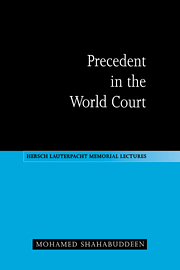Book contents
- Frontmatter
- Contents
- Foreword
- Preface
- List of abbreviations
- 1 Introduction
- 2 The growth of the Court's case law
- 3 Range of precedential resources
- 4 The bases of the system
- 5 The Advisory Committee of Jurists
- 6 The view taken by the League of Nations
- 7 The possibility of judge-made international law
- 8 Stare decisis
- 9 Distinguishing
- 10 Departing from a previous decision
- 11 Ratio decidendi and obiter dictum
- 12 Advisory opinions and decisions of chambers
- 13 The precedential impact of individual opinions
- 14 Effect and scope of the Court's case law
- 15 Conclusion
- Index
11 - Ratio decidendi and obiter dictum
Published online by Cambridge University Press: 04 May 2010
- Frontmatter
- Contents
- Foreword
- Preface
- List of abbreviations
- 1 Introduction
- 2 The growth of the Court's case law
- 3 Range of precedential resources
- 4 The bases of the system
- 5 The Advisory Committee of Jurists
- 6 The view taken by the League of Nations
- 7 The possibility of judge-made international law
- 8 Stare decisis
- 9 Distinguishing
- 10 Departing from a previous decision
- 11 Ratio decidendi and obiter dictum
- 12 Advisory opinions and decisions of chambers
- 13 The precedential impact of individual opinions
- 14 Effect and scope of the Court's case law
- 15 Conclusion
- Index
Summary
Introductory remarks
From the fact that stare decisis is not a doctrine in force with the Court, does it follow that the Court does not need to distinguish between ratio decidendi and obiter dictum? A view, which commands respect, is that to draw that distinction ‘would be to accept the doctrine of stare decisis at a theoretical level’. Is this necessarily so in the case of the Court? What, if anything, does its practice show?
In English law one ground on which a judicial pronouncement need not be followed is that it does not form part of the ratio decidendi. There has been controversy as to what exactly this is. The term may be taken generally to mean ‘any rule of law expressedly or impliedly treated by the judge as a necessary step in reaching his conclusion’; theoretically, anything else is obiter. At the practical level, difficulties are, however, encountered in deciding how much of a judgment is ratio decidendi and how much is obiter. Arguably, the greater the lack of precision in the methods of ascertaining where the line is to be drawn, the greater the degree to which the doctrine of precedent can be weakened. But the problem has its good side: its existence and the need to resolve it when it arises provide leeways for judicial choice.
- Type
- Chapter
- Information
- Precedent in the World Court , pp. 152 - 164Publisher: Cambridge University PressPrint publication year: 1996



